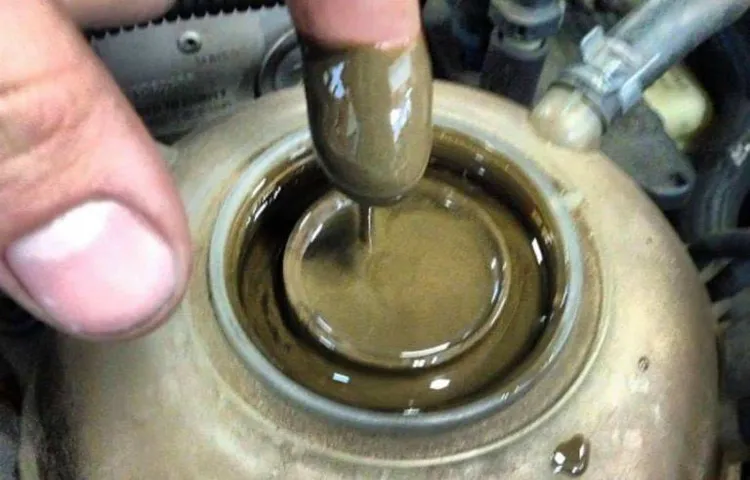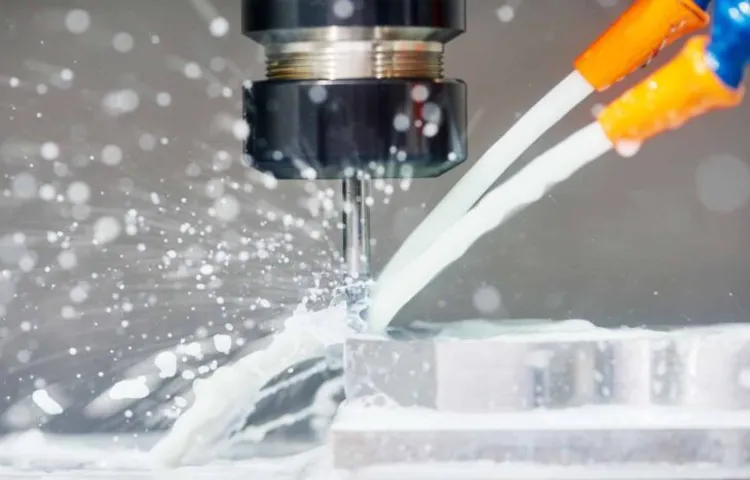When it comes to keeping our vehicles running smoothly, one important aspect is maintaining the right coolant mixture. But what exactly is a common water to coolant mixture, and why is it important? Well, think of your vehicle’s cooling system as a lifeline. Just like how we rely on water to stay hydrated and keep our bodies functioning properly, our vehicles depend on coolant to regulate their temperature and prevent overheating.
In this blog, we will explore the common water to coolant mixture, its composition, and why it is crucial for the health and performance of your vehicle. So, let’s dive in and take a closer look!
Table of Contents
Understanding Water and Coolant Mixtures
When it comes to the common water to coolant mixture, a popular ratio is 50/50, which means equal parts water and coolant. This mixture is commonly used in automotive cooling systems to help regulate engine temperature and prevent overheating. The water helps to transfer heat away from the engine, while the coolant contains additives that prevent corrosion and provide lubrication.
This balanced mixture is effective in most climates and provides sufficient protection against freezing and boiling. However, it’s important to note that the specific mixture ratio may vary depending on the manufacturer’s recommendations and the climate in which the vehicle is being operated. It’s always a good idea to consult the owner’s manual or speak with a mechanic to determine the best water to coolant ratio for your specific vehicle.
Introduction to Water and Coolant Mixture
water and coolant mixture, coolant ratio, coolant properties, engine cooling system When it comes to keeping our vehicles running smoothly, one factor that often goes unnoticed is the water and coolant mixture in our engine’s cooling system. But what exactly is a water and coolant mixture, and why is it important? To put it simply, a water and coolant mixture is a combination of water and an antifreeze coolant that is used to regulate the temperature of our engine. The coolant is typically a mixture of ethylene or propylene glycol, along with additives that help enhance its properties.
The ratio of water to coolant is crucial in ensuring the effectiveness of the mixture. Too much water can result in boiling and freezing issues, while too much coolant can impede heat transfer. The ideal ratio is usually a 50:50 mixture, but this can vary depending on the climate and the specific requirements of your vehicle.
So why is this mixture so important? Well, the engine cooling system is responsible for maintaining the optimum temperature for the engine to function properly. If the mixture is not balanced correctly, it can lead to overheating, which can cause serious damage to the engine. On the other hand, if the mixture is too strong, it can result in poor heat transfer and reduced cooling efficiency.
Additionally, the coolant also plays a role in preventing corrosion and cavitation within the engine. Cavitation occurs when tiny bubbles form within the coolant, which can cause damage to the engine components over time. The additives in the coolant help to control these issues, ensuring the longevity and reliability of the engine.
To ensure your engine stays cool and functions at its best, it’s essential to regularly check and maintain the water and coolant mixture in your cooling system. This involves monitoring the coolant level, checking for any leaks, and performing regular coolant flushes to remove any contaminants. In conclusion, understanding the importance of the water and coolant mixture in our engine’s cooling system is crucial for maintaining the performance and longevity of our vehicles.
By ensuring the correct ratio and regularly maintaining the coolant, we can prevent overheating, corrosion, and other issues that can lead to costly repairs. So, the next time you pop the hood of your car, make sure to give some attention to the water and coolant mixture that keeps your engine running smoothly.

Role of Water in Cooling Systems
cooling systems, water and coolant mixtures
Role of Coolant in Cooling Systems
coolant, cooling systems, water and coolant mixtures, role of coolant
Importance of the Water to Coolant Mix
water to coolant mixture, understanding water and coolant mixtures When it comes to cooling your engine, it’s important to understand the importance of the water to coolant mixture. The mixture of water and coolant is what keeps your engine running smoothly and prevents it from overheating. It acts as a heat transfer medium, absorbing the excess heat generated by the engine and dissipating it through the radiator.
Water is an excellent heat conductor and can effectively absorb large amounts of heat. However, using pure water as a coolant is not advisable as it can freeze in cold weather or boil at high temperatures. This is why coolant, also known as antifreeze, is added to the water.
Coolant is specifically designed to lower the freezing point and raise the boiling point of the water, ensuring that it remains in a liquid state regardless of the temperature. The ratio of water to coolant in the mixture is crucial. A common recommendation is a 50/50 mixture, with equal parts of water and coolant.
This ensures that the coolant has enough concentration to provide adequate freezing and boiling point protection, while still allowing water to effectively transfer heat. Too much water in the mixture can result in inadequate protection against freezing or boiling, while too much coolant can reduce the efficiency of heat transfer. It’s also important to use the right type of coolant for your engine.
Different engines require different types of coolant, so it’s always best to consult your vehicle’s owner’s manual or seek advice from a professional. Using the wrong coolant can lead to corrosion, cavitation, or other engine problems. In conclusion, understanding the water to coolant mixture is crucial for maintaining the optimal performance of your engine.
By using the right ratio and type of coolant, you can ensure that your engine remains cool and protected from extreme temperatures. So, next time you check your coolant levels, remember the importance of the water to coolant mix.
Common Water to Coolant Mixture Ratios
“What is a common water to coolant mixture?” A common water to coolant mixture ratio refers to the proportion of water and coolant that should be mixed together in a vehicle’s cooling system. This mixture is important as it helps regulate the engine’s temperature and prevent it from overheating. The most common ratio used is 50:50, which means equal parts of water and coolant.
This mixture provides a good balance of cooling and freeze protection. However, in extreme weather conditions, such as very cold temperatures, a higher concentration of coolant may be necessary to prevent freezing. On the other hand, in hotter climates, a higher concentration of water may be used to improve cooling efficiency.
It is important to follow the manufacturer’s recommendations for the specific vehicle and coolant being used to ensure optimal performance and protection for the engine.
Understanding the Ratios
Understanding the Ratios: Common Water to Coolant Mixture Ratios When it comes to maintaining your vehicle’s cooling system, understanding the right water to coolant mixture ratios is crucial. The ratio of water to coolant determines the overall effectiveness of your cooling system in regulating the engine temperature. It’s important to note that different vehicles and engines may require slightly different ratios, so it’s essential to consult your vehicle’s manual or seek professional advice to get the right recommendation.
However, a common water to coolant mixture ratio is typically 50% water and 50% coolant, also known as a 50/50 mixture. This 50/50 ratio is a popular choice because it offers a balanced solution that provides adequate cooling and freeze protection. The water in the mixture helps absorb and carry away excess heat from the engine, while the coolant (usually a mixture of antifreeze and water) prevents freezing in cold temperatures and protects against corrosion and overheating.
Using a 50/50 mixture ensures that your cooling system is prepared for both hot and cold weather conditions. In colder climates, the antifreeze properties of the coolant prevent the mixture from freezing and potentially causing damage to the engine. On the other hand, the mixture also provides sufficient cooling in hotter climates by maintaining optimum engine temperatures.
However, it’s important to note that there may be variations in the recommended ratios depending on factors such as the type of coolant used, the climate you live in, and the specific requirements of your vehicle. It’s always best to consult your vehicle’s manual or seek professional advice to ensure you’re using the correct ratio for your specific circumstances. Remember, maintaining the right water to coolant ratio is essential for the optimal performance and longevity of your vehicle’s cooling system.
By following the recommended mixture ratios and regularly checking and topping up your coolant levels, you can ensure that your engine stays cool and protected, no matter the weather conditions. So don’t overlook the importance of understanding and using the correct ratios – your engine will thank you for it!
Common Ratios for Different Cooling Systems
Water to coolant mixture ratios are an important consideration when it comes to maintaining the optimal performance and efficiency of cooling systems. The ratio of water to coolant can vary depending on the type of cooling system being used. For example, in automotive cooling systems, the most common mixture ratio is 50% coolant and 50% water.
This balanced mixture helps to prevent freezing in cold temperatures while also providing effective heat transfer and corrosion protection. In contrast, industrial cooling systems may require different ratios depending on the specific application. Some processes may require a higher concentration of coolant to provide additional protection against corrosion or to handle higher temperature requirements.
It’s important to consult the manufacturer’s recommendations or seek professional advice to determine the appropriate water to coolant mixture ratio for your specific cooling system. By maintaining the correct ratio, you can ensure the longevity and efficient operation of your cooling system.
Factors Affecting the Mixture Ratios
factors affecting the mixture ratios
Benefits of Using the Right Water to Coolant Mixture
One common water to coolant mixture that is often used is a 50/50 blend. This means that equal parts water and coolant are mixed together to create the ideal solution for cooling your engine. Using the right water to coolant mixture can have several benefits.
Firstly, it helps to regulate the temperature of your engine, preventing it from overheating. This is important because if your engine gets too hot, it can cause damage and decrease its overall lifespan. Secondly, the right mixture can help to prevent corrosion and rust from forming within your cooling system.
This is crucial because corrosion can lead to leaks and other costly repairs. Lastly, using the right water to coolant mixture can improve the overall efficiency of your engine, allowing it to run smoothly and perform at its best. So, taking the time to ensure that you have the correct water to coolant ratio in your cooling system can go a long way in preventing damage and ensuring optimal performance.
Enhanced Heat Transfer Efficiency
water to coolant mixture, heat transfer efficiency, benefits
Improved Corrosion Protection
water to coolant mixture, improved corrosion protection
Preventing Cavitation and Boiling Issues
water to coolant mixture, preventing cavitation and boiling issues, benefits, right mixture
Choosing the Right Water to Coolant Mixture
When it comes to choosing the right water to coolant mixture, there are a few things to consider. The most common mixture is a 50/50 ratio of water to coolant, also known as antifreeze. This combination provides optimal performance and protection for your engine in both hot and cold temperatures.
The water helps to regulate the temperature of the coolant and prevent it from freezing or boiling. The coolant, on the other hand, contains additives that help prevent corrosion and lubricate the engine. By using this balanced mixture, you can ensure that your engine stays cool and protected all year round.
Considering the Vehicle Manufacturer’s Recommendations
vehicle manufacturer’s recommendations, choosing the right water to coolant mixture. When it comes to maintaining our vehicles, it’s important to follow the recommendations set forth by the manufacturer. This includes choosing the right water to coolant mixture for your radiator.
The water to coolant ratio can have a big impact on the overall performance and longevity of your engine. So, how do you know what ratio is right for your vehicle? Well, it depends on a few factors. To start, you’ll want to check the owner’s manual or consult with a professional to see if the manufacturer has any specific recommendations for your vehicle.
Some manufacturers may recommend a 50/50 mix of coolant and water, while others may suggest a different ratio. This is because different engines and climates require different levels of protection. For example, if you live in a colder climate, you may want to use a higher concentration of coolant to prevent freezing.
On the other hand, if you live in a hot climate, you may want to use more water to aid in heat transfer. Ultimately, it’s important to follow the manufacturer’s recommendations to ensure optimal performance and avoid any potential damage to your engine. So, take the time to check the manual or consult with a professional to make sure you’re choosing the right water to coolant mixture for your vehicle.
Consulting with a Professional Mechanic
water to coolant mixture, professional mechanic When it comes to choosing the right water to coolant mixture for your vehicle, it’s always a good idea to consult with a professional mechanic. They have the knowledge and experience to guide you in making the best decision for your specific vehicle and driving conditions. A professional mechanic will take into consideration several factors when determining the appropriate water to coolant ratio.
This includes the type of coolant recommended by the vehicle manufacturer, the climate in which you are driving, and any specific needs or concerns you may have. In colder climates, a higher concentration of coolant may be necessary to prevent freezing. On the other hand, in hotter climates, a higher concentration of water may be needed to keep the engine from overheating.
A professional mechanic can also advise you on the type of coolant to use. There are different types of coolant available, including ethylene glycol-based and propylene glycol-based coolants. The choice between these two types depends on factors such as the age of your vehicle, any existing coolant leaks, and whether or not you have pets or small children who may come into contact with the coolant.
Overall, consulting with a professional mechanic is the best way to ensure you are choosing the right water to coolant mixture for your vehicle. They can provide expert advice based on their knowledge and experience, taking into consideration your specific needs and driving conditions. So, don’t hesitate to reach out to a professional mechanic for guidance.
Testing the Mixture Ratio
water to coolant mixture, cooling system, engine temperature, optimal mixture ratio, overheating, coolant effectiveness. Have you ever wondered what the right water to coolant mixture is for your car’s cooling system? Well, look no further because we’re here to break it down for you. The water to coolant mixture plays a crucial role in keeping your engine temperature at optimal levels and preventing it from overheating.
Finding the right mixture ratio is essential for maximizing cooling efficiency and protecting your engine from damage. So, how do you choose the right mixture? Firstly, it’s important to understand that the water to coolant ratio refers to the amount of water and coolant that you mix together. The optimal mixture ratio depends on your specific vehicle and the climate in which you live.
In warmer climates, where the engine is more prone to overheating, a higher concentration of coolant is recommended. On the other hand, in cooler climates, a higher concentration of water may be more suitable. But why is the water to coolant mixture so important? Well, the coolant is responsible for absorbing and transferring heat away from the engine, while the water helps in dissipating that heat.
The coolant also contains additives that help lubricate the cooling system and prevent the formation of rust and corrosion. If the mixture ratio is too high in coolant, it can reduce the effectiveness of the coolant in absorbing heat, leading to engine overheating. Conversely, if the mixture ratio is too high in water, it can reduce the effectiveness of the coolant additives, leading to increased corrosion and possible damage to the engine.
To determine the optimal water to coolant mixture for your vehicle, it’s recommended to check your owner’s manual or consult a professional mechanic. They can provide you with specific guidelines based on your car’s make and model. It’s also important to keep in mind that the mixture ratio may need to be adjusted depending on the season and temperature fluctuations.
Regular monitoring of your coolant levels and adding the appropriate mixture as needed will help ensure the cooling system’s efficiency and prolong your engine’s lifespan. In conclusion, choosing the right water to coolant mixture in your vehicle’s cooling system is crucial for maintaining the engine’s temperature and preventing overheating. Finding the optimal mixture ratio depends on various factors such as climate, vehicle specifications, and season.
Conclusion and Final Thoughts
So, what is a common water to coolant mixture, you ask? Well, it’s like the ultimate partnership – a match made in thermodynamic heaven. Imagine a refreshing glass of water, cool and crisp, flowing through the veins of an engine, providing hydration and preventing overheating. Now, add in a dash of coolant, the superhero of liquids, with its anti-freeze powers and ability to withstand extreme temperatures.
Together, they form a dynamic duo, ensuring that your engine stays chill even in the hottest moments. It’s a harmonious blend that keeps things balanced, like water and oil, or peanut butter and jelly. So, next time you think about the perfect team, forget Batman and Robin or Holmes and Watson – think water and coolant, the unbeatable duo keeping your engine cool, calm, and collected.
FAQs
What is a common water to coolant mixture used in engines?
A common water to coolant mixture used in engines is a 50/50 blend of water and coolant (antifreeze).
Why is a water to coolant mixture important in engines?
A water to coolant mixture is important in engines as it helps to regulate the engine temperature and prevent overheating.
Can I use just water instead of a coolant in my engine?
While water can be used in an emergency situation, it is not recommended to use just water in your engine long-term. Coolant adds vital anti-corrosion and anti-freeze properties.
What happens if the coolant mixture in my engine is too diluted?
If the coolant mixture in your engine is too diluted, it may not provide sufficient anti-freeze protection and can potentially lead to freezing or overheating issues.
Is it necessary to use a specific type of coolant in my engine?
It is important to use the type of coolant specified by your vehicle manufacturer as different engines may require different types of coolant to ensure optimal performance and protection.
How often should I check and change the coolant mixture in my engine?
It is recommended to check and change the coolant mixture in your engine according to the maintenance schedule outlined in your vehicle’s owner’s manual.
Can I mix different brands or types of coolant in my engine?
It is generally not recommended to mix different brands or types of coolant in your engine as it can lead to chemical reactions and may not provide the desired level of protection. Always consult your vehicle manufacturer’s recommendations.



